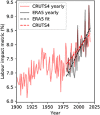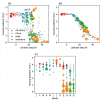Regional disparities and seasonal differences in climate risk to rice labour
- PMID: 34795795
- PMCID: PMC8592055
- DOI: 10.1088/1748-9326/ac3288
Regional disparities and seasonal differences in climate risk to rice labour
Abstract
The 880 million agricultural workers of the world are especially vulnerable to increasing heat stress due to climate change, affecting the health of individuals and reducing labour productivity. In this study, we focus on rice harvests across Asia and estimate the future impact on labour productivity by considering changes in climate at the time of the annual harvest. During these specific times of the year, heat stress is often high compared to the rest of the year. Examining climate simulations of the Coupled Model Intercomparison Project 6 (CMIP6), we identified that labour productivity metrics for the rice harvest, based on local wet-bulb globe temperature, are strongly correlated with global mean near-surface air temperature in the long term (p ≪ 0.01, R 2 > 0.98 in all models). Limiting global warming to 1.5 °C rather than 2.0 °C prevents a clear reduction in labour capacity of 1% across all Asia and 2% across Southeast Asia, affecting the livelihoods of around 100 million people. Due to differences in mechanization between and within countries, we find that rice labour is especially vulnerable in Indonesia, the Philippines, Bangladesh, and the Indian states of West Bengal and Kerala. Our results highlight the regional disparities and importance in considering seasonal differences in the estimation of the effect of climate change on labour productivity and occupational heat-stress.
Keywords: agriculture; climate change; heat stress; seasonal.
© 2021 The Author(s). Published by IOP Publishing Ltd.
Figures








References
-
- International Labour Organization Employment by sex and economic activity—ILO modelled estimates. 2019. available at: https://ilostat.ilo.org/
-
- Zhao Y, Ducharne A, Sultan B, Braconnot P, Vautard R. Estimating heat stress from climate-based indicators: present-day biases and future spreads in the CMIP5 global climate model ensemble. Environ. Res. Lett. 2015;10:084013. doi: 10.1088/1748-9326/10/8/084013. - DOI
Grants and funding
LinkOut - more resources
Full Text Sources
